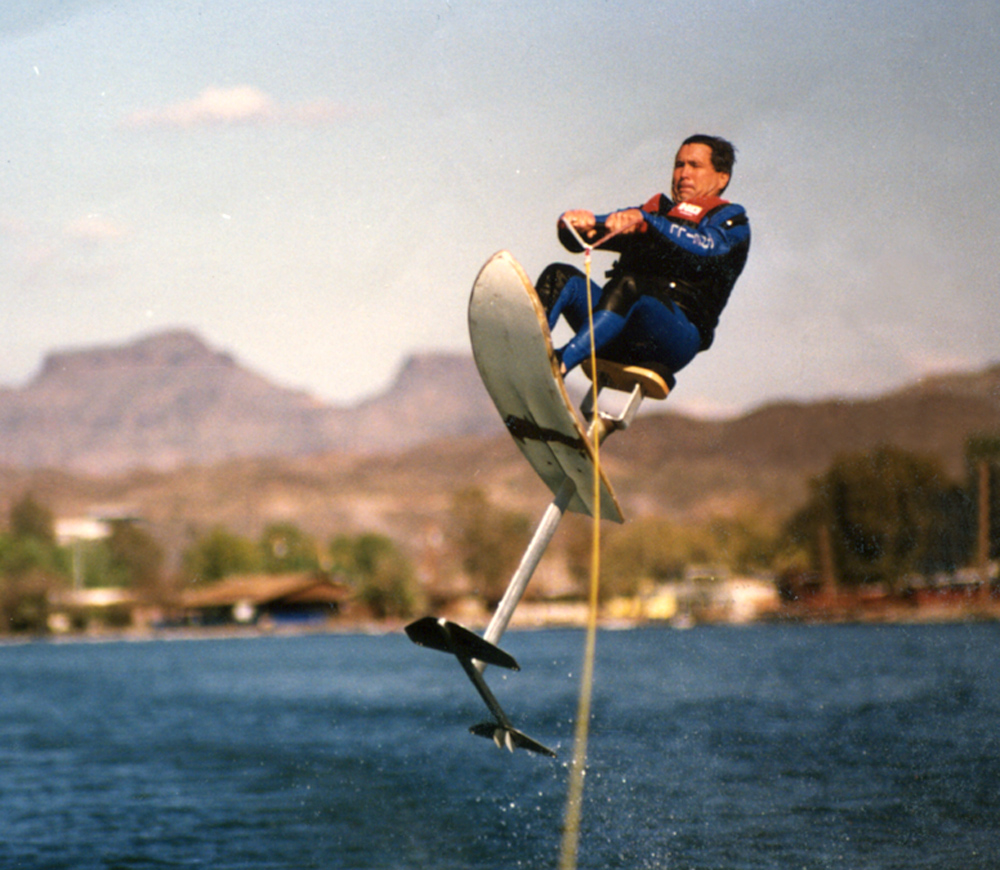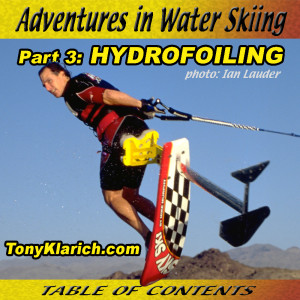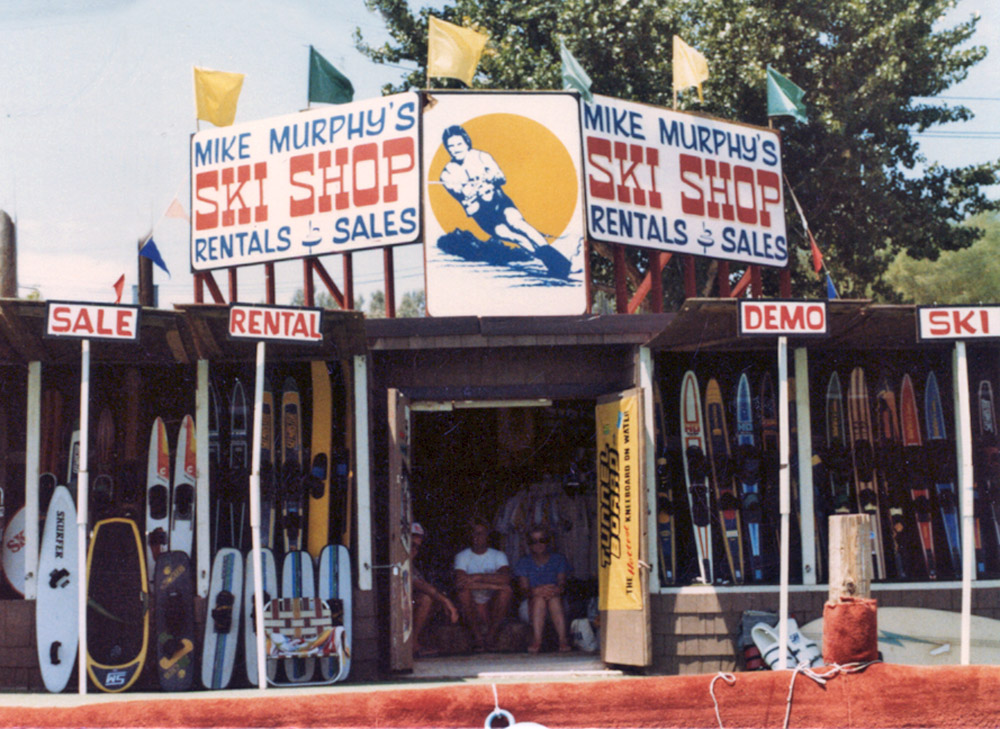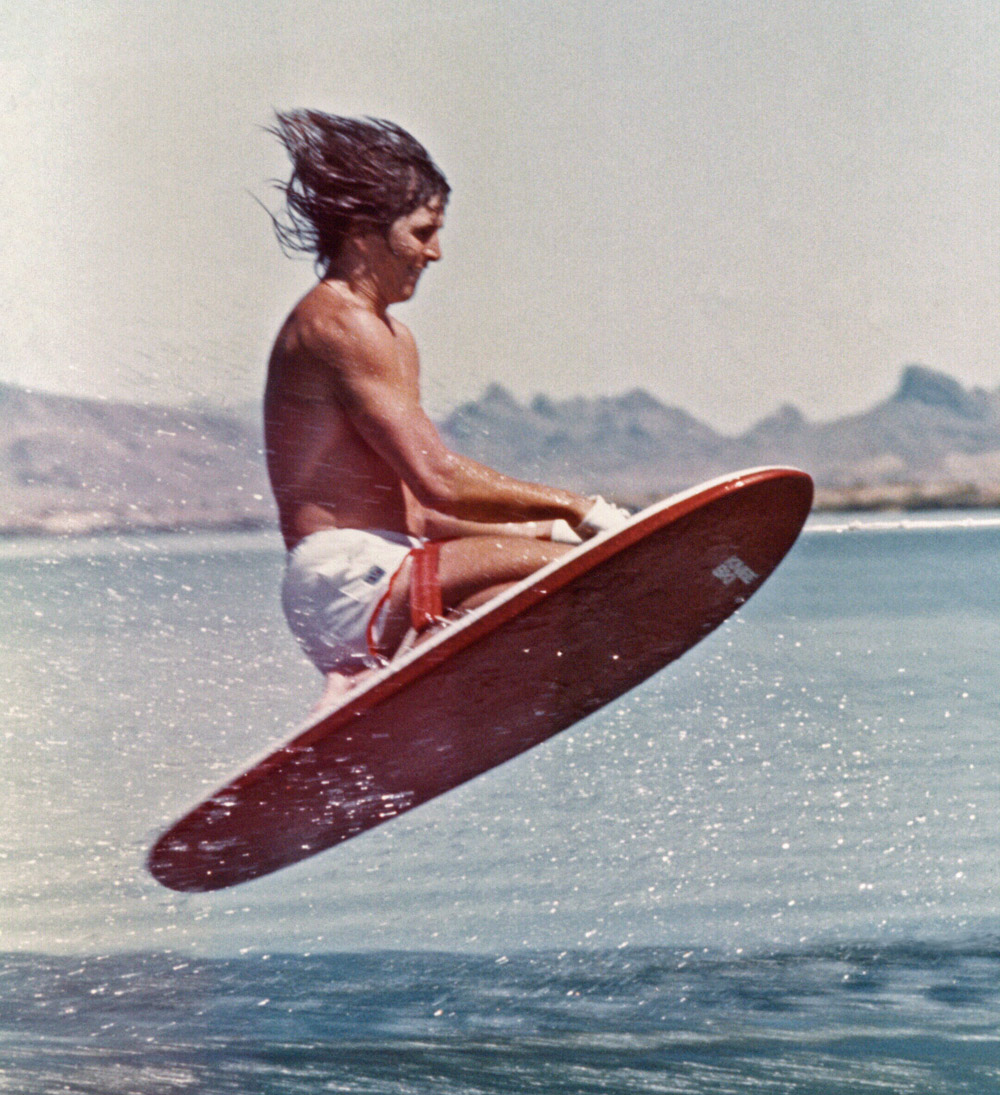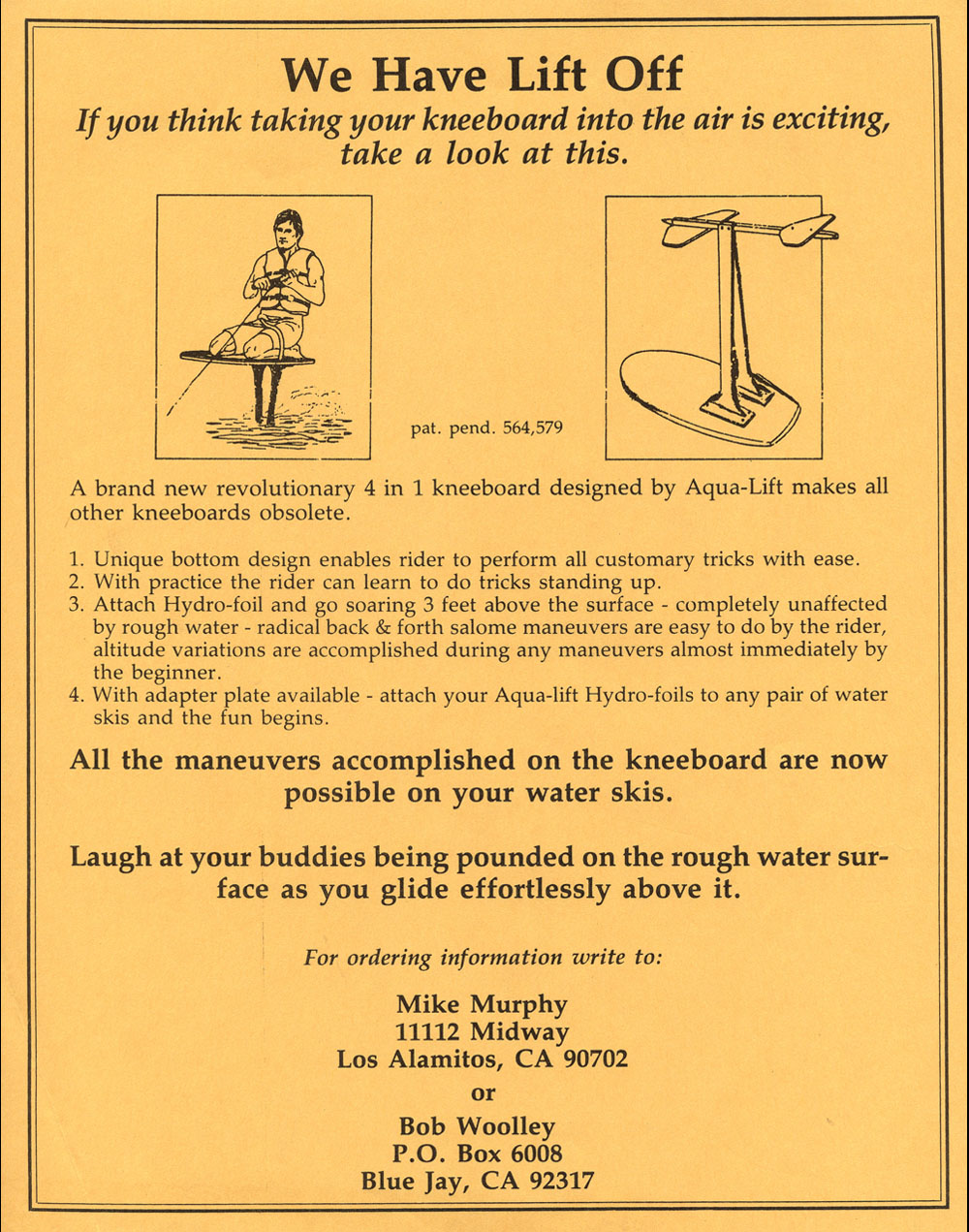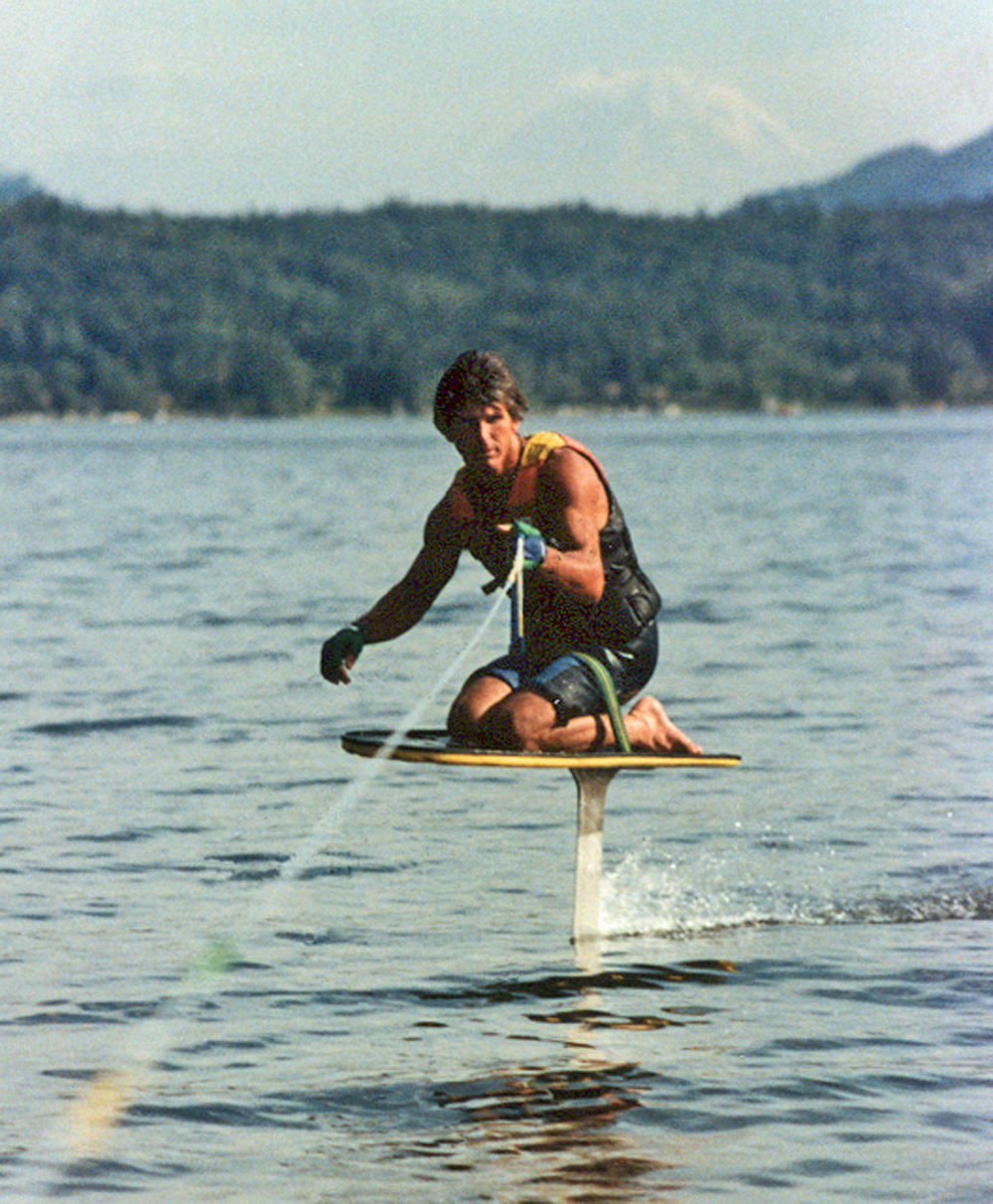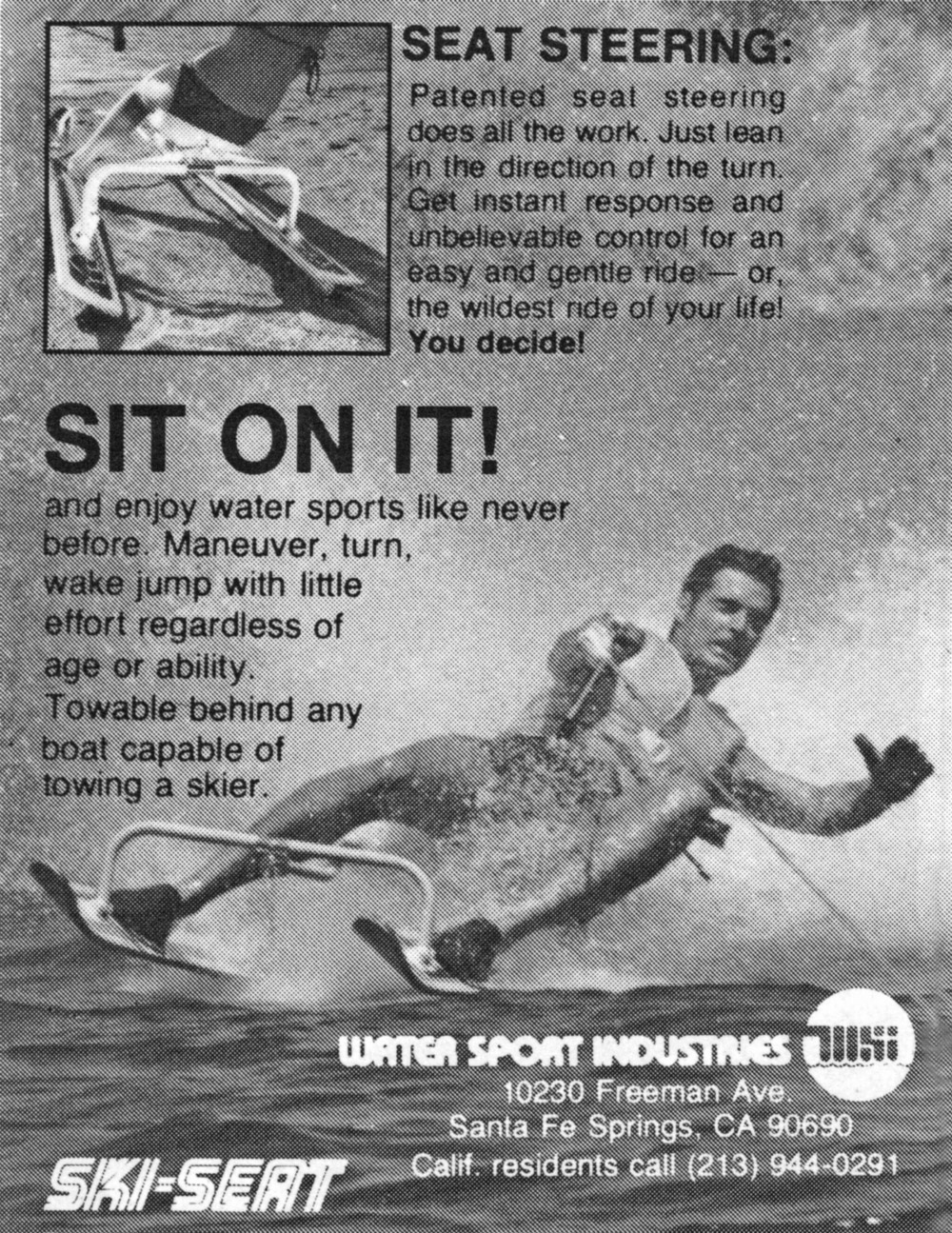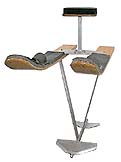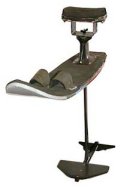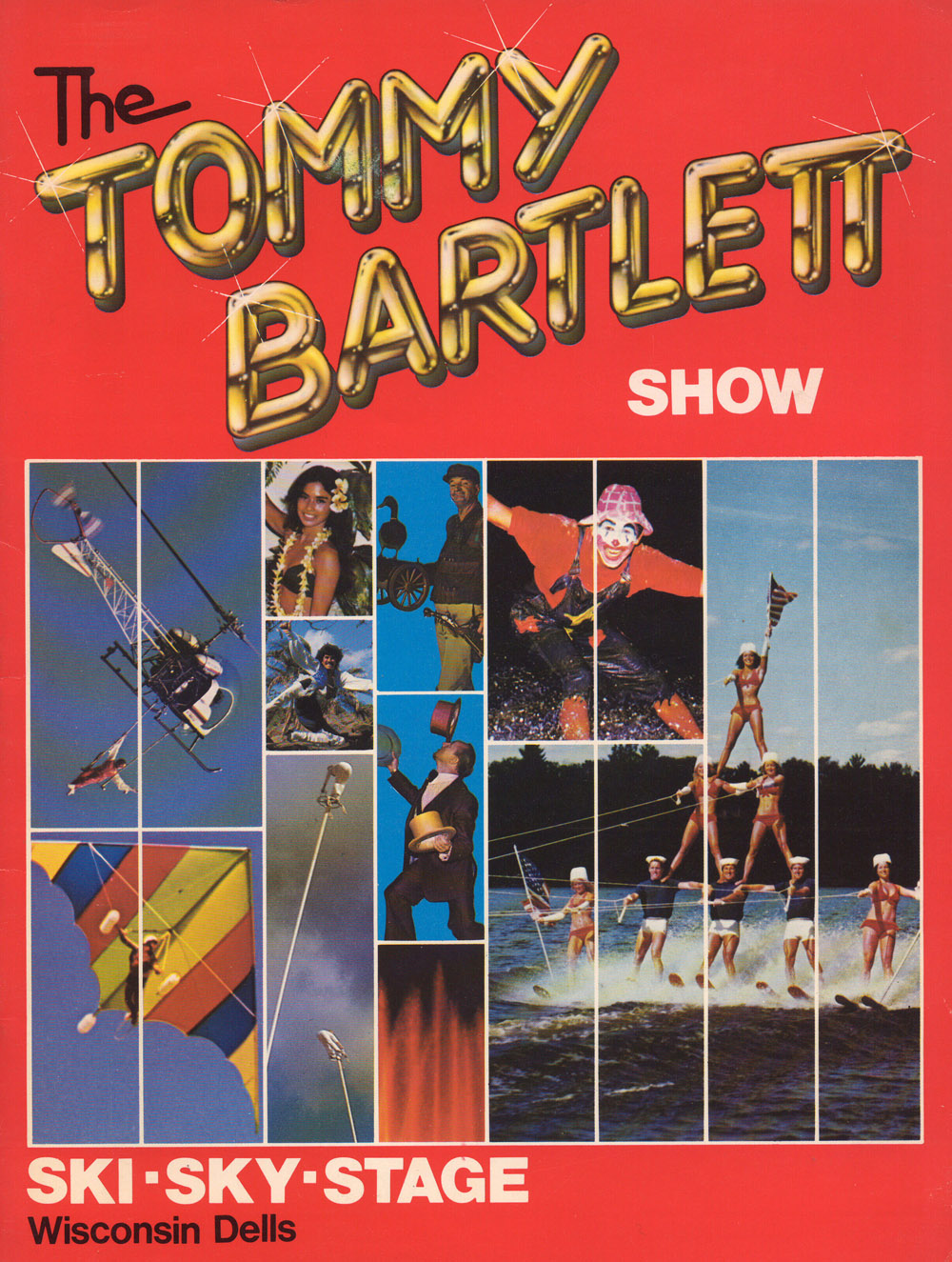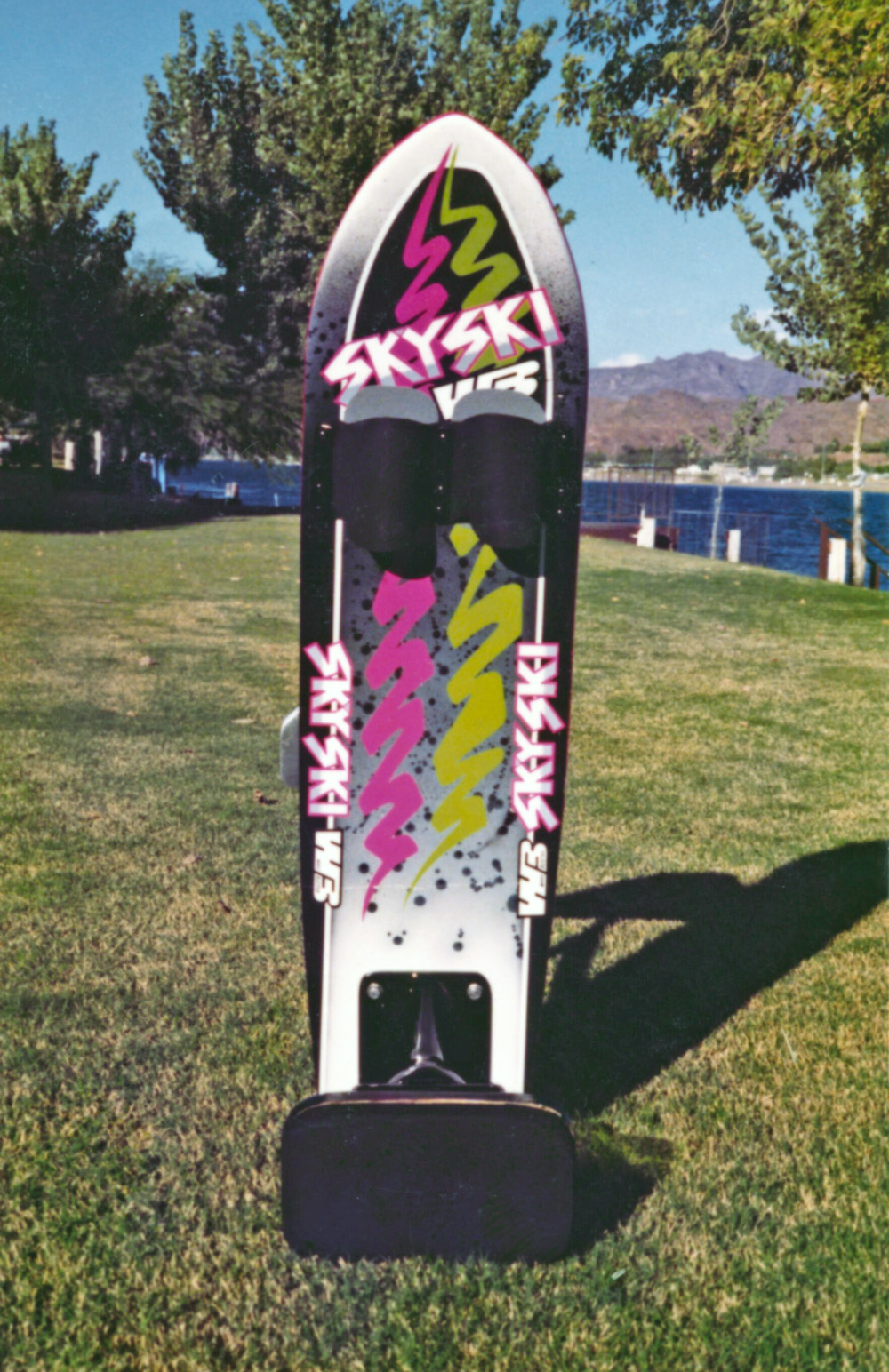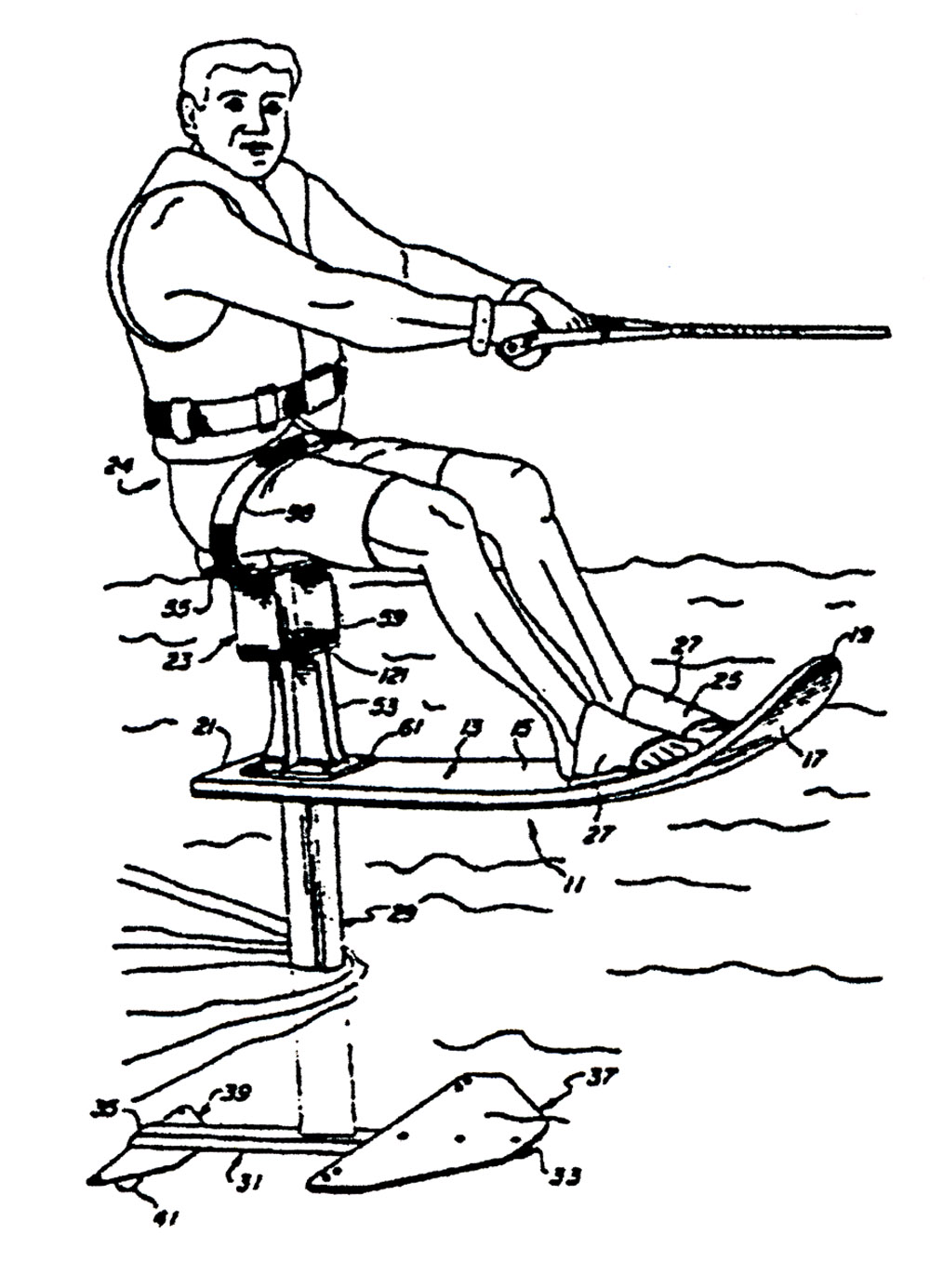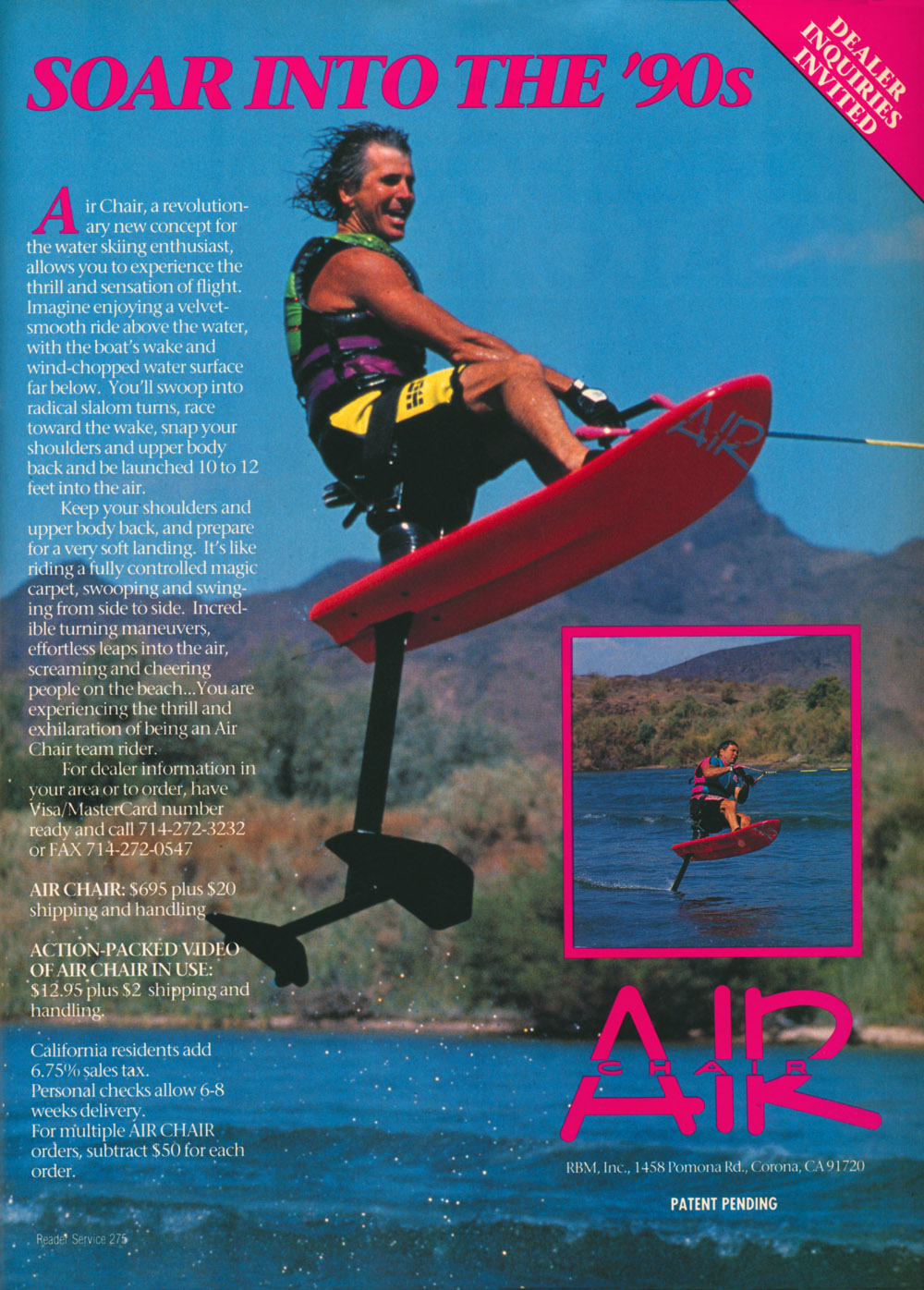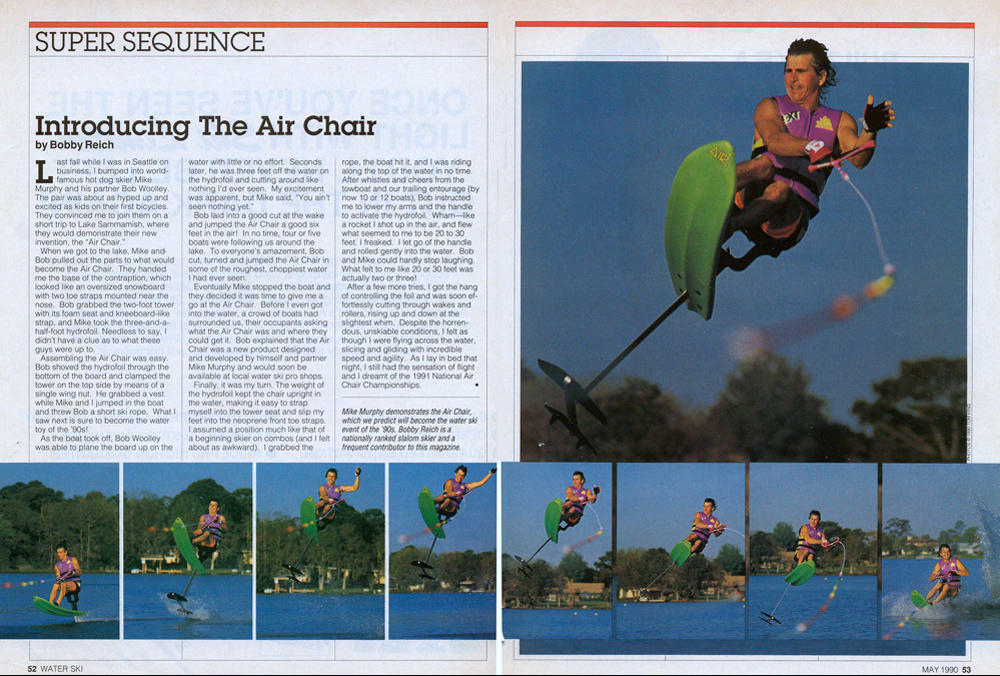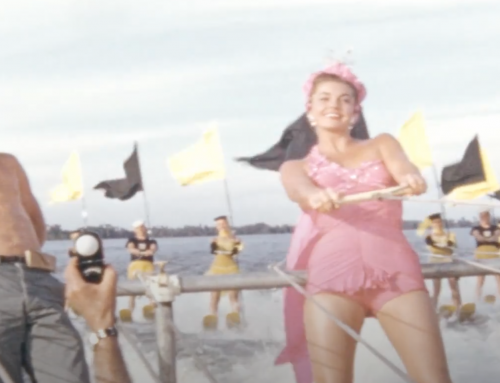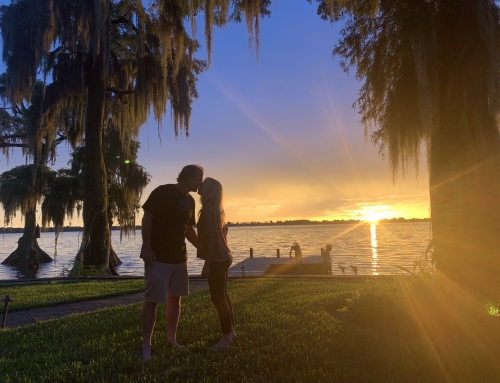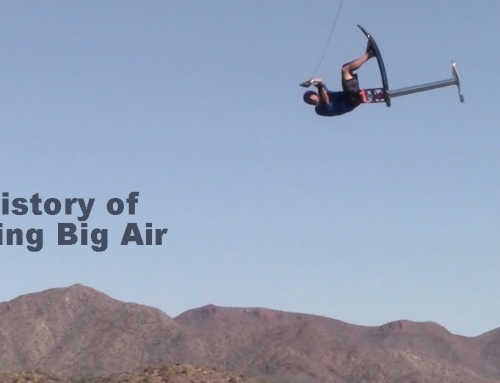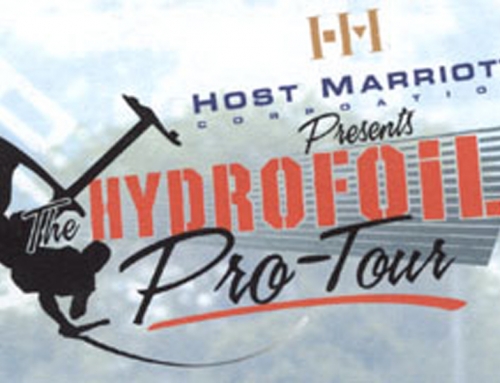KNEEBOARD HYDROFOIL > AIR CHAIR (1983-1991)
It was the early summer of 1983, and I found myself in the midst of all the action while working full time for Mike at his “Ski Shop” on the Parker Strip of the Colorado River. Uncle Mike’s collection of rental equipment became the fodder for the next big breakthrough in foiling. We spent weeks mounting up his various rentals to a hydrofoil. A slalom ski was impossible and the trick skis worked well. Mike tried the kneeboard on a hydrofoil next, but was unable to ride it. He gave me a shot and I took relish in being the first one to successfully fly it.
Mike’s ski shop on the Parker Strip of the Colorado River, 1985.
(Note: 1st Skurfer on left)
Mike was the co-inventor of the kneeboard in 1972.[i] He felt one of the drawbacks of kneeboarding was not being able to use your knees as “the shock absorbers God gave us.” In Mike’s mind the foil under the board took the place of the shock absorbers, and now riders could ride smoothly above the chop. While that was true, it still required the kneeling position, which was generally uncomfortable for most riders.
Mike rides the Knee Ski: the world’s first production kneeboard for water skiing, 1973
Enter Bob Woolley. He owned the trailer next door to Mike’s ski shop at the Windmill Resort, and he was witness to all of the crazy stuff we were trying. Bob was skilled craftsman who could take an idea and create a finished product that was ready to ride. Mike and Bob decided to team up and develop the hydrofoil kneeboard. Mike was the idea guy and promoter, while Bob was the builder.
“The Aqua-Lift makes all other kneeboards obsolete.” 1985
Mike rides the single strut kneeboard hydrofoil. (Khoury, 1985)
Mike and Bob eventually sold the “Aqua-Lift” to Kransco, the makers of the Hydroslide kneeboard.[ii] Sometime after buying the license for the hydrofoil kneeboard, but before it actually went into production, Kransco figured out that it could be dangerous. One of their test riders ejected from the hydrofoil kneeboard, and the huge assembly with a sharp strut and wings caused an injury. Kransco pulled the plug on the project. Mike and Bob were forced to the sidelines, having signed an agreement not to ride their own hydrofoil kneeboards for five years.
Another piece of rental equipment on Mike’s dock was called the Ski Seat. This yellow contraption consisted of two skis with bindings held together by a series of bent tubes. It had a seat, and the whole thing swiveled right and left when you leaned into a turn. Bob Woolley liked the Ski Seat so much he bought one himself, and spent an entire summer cruising it up and down the River.
Mike Rented the Ski Seat at his ski school on the river, 1981
Just one-door down from the ski shop, Bob saw us mounting the rental dock’s various rides onto the foils, so now it was his turn to experiment too. Bob had already spent time riding his hydrofoil kneeboard in the seated position. He did not kneel because the long rides eventually gave him nerve damage. He enjoyed the feeling of sitting and flying, but because of the agreement signed with Kransco, Bob had to find something other than a kneeboard hydrofoil to sit and foil on. He figured that the next best thing to mount up on a foil was something like the Ski Seat. Bob used the basic design of the Ski Seat as a template, but handcrafted the ski assembly. He mounted it onto a double strut foil with improved wings for lift. In doing so Bob Woolley created the first sit down hydrofoil.[ii] It wasn’t long before Bob was jumping higher than all of us, even though we were riding the stand up foils and could use our legs.
Once Bob became the top dog for big air, the competitive fires were lit under Mike. He took Bob’s new creation out for a ride. Mike liked the feeling, but recalls being bothered by the splash when the two skis bounced off the water. Mike joked that he just wasn’t “man enough” to take the constant slap of spray at his “gonads”, and couldn’t deal with the “brown water” shooting out of his ears.
Bob Woolley’s original sit down hydrofoil (double strut, double skis, circa 1986)
Mike enjoyed riding Bob’s new sit down foil, and gave his suggestions to Bob: push the two skis together into a single unit, and use the single strut foil he developed with Buck Buxton.
Bob was already in the process of moving the skis closer and closer together, and was also considering the single strut foil already in use on the kneeboard hydrofoil. Shortly after Mike’s first ride and suggestions, Bob put together the first single ski, single strut, sit down hydrofoil.
Woolley jumping the first single strut hydrofoil. Note: no seatbelt or footstraps! April, 1988
Bob knew he had something special, and began testing his designs in private, much to the concern of Mike. One day a group of men showed up to Bob’s trailer for a demonstration of the new toy. Mike felt something was going on, and went to find out who they were. He was surprised to discover that they were a group of investors interested in “Bob’s” new sit down foil. Bob believed that being the one to physically make the foil made him the exclusive owner of the potential company. Mike believed that he had a claim too, so he informed the investors of his position. In subsequent debates over percentages Mike informed the involved parties that he believed he had every right to manufacture foils too, and would do so if he did not receive what he felt was fair. With all his connections in the water ski world, that was the trump card that turned the tide. Bob, Mike, and the investors signed an agreement and warily moved forward to try and develop a product everyone could use.
Bob was the first King of Big Air. It was amazing to see him launch into huge jumps without a seat belt. He was easily clearing six feet with perfect form. But for most people who tried the sit down foil, the problem was coming detached. When that happened it was downright dangerous to have the forty-something pound ski come loose in the air. Most everyone who rode one of the early boards had a harrowing experience with the free flying foil. I was no exception.
In 1988 Mike brought the first prototype up to Washington to show it to Herb O’Brien. Mike was in search of a manufacturer for the deck, and Herb, the owner of HO Skis, was just the one to make them. Mike brought the contraption to Lake Sammamish to show it off for Herb and the guys at HO. I was on site because it was the weekend of the annual HO sales meeting and picnic. Mike volunteered me as a crash test dummy – it was my first time riding the sit down foil. The ski was still a prototype. The pink and blue deck was hand made by Eliminator Boats, and it did not have a seat belt or heel straps.
The first “modern” prototype. No seatbelt or footstraps made this a dangerous ride. (1988)
Uncle Mike taught me how to fly without too much effort. My years on the stand up foils, and experience on the hydrofoil kneeboard were great preparation for this new ride. But learning to ride was only the opening act. Act II was trying to do a wake-to-wake jump, just like on the stand ups. I had a picture in my head of what a wake jump should be like, and it was based on what Woolley was doing: big double wake jumps. I planned on using the same approach, but backing it off just a bit. Without fear, hesitation, or the thought of possible injury, I took a pretty good cut at the wake and went for the jump. It wasn’t too bad. I cleared both wakes in fairly good position, but was just a little crooked. That was all it took to lose control. The board bounced like a bucking bronco, and without a seat belt I immediately ejected. I had just enough time to register that things were not good. I was free flying next to a forty-pound monster with a blade. It felt like a cheesy late night TV for the Ginsu Knife…”it slices, it dices…” I tucked up into a ball and covered my head. The leading edge of the strut caught cut me across the shin, even though a full-length wetsuit. The slice was deep but not very long. There was a lot of blood, and I probably should have gotten stitches. My minor flesh wound put an end to my Air Chairing for over three years.
Mike had a similar experience with a crash on the Air Chair, and cut his arm so badly that he still has the scar after 20 years. He refused to ride it again because he thought that another crash like that could be lethal. So he got a pushbutton car seat belt from a junkyard and mounted it to his seat tower. In just a couple of rides Mike vaulted past Bob to become the new King of Big Air. Riding with a seatbelt was not only safer; it also offered much better performance. Woolley took the seatbelt concept proven by Mike, and designed a belt specifically for the Air Chair with a buckle and clasp.
Robert Woolley, Brad Barnett, and Mike Murphy formed the RBM Corporation to manufacture and sell sit down hydrofoils. The first major coverage came quickly in the National Enquirer with Bob Woolley doing a big jump with Sky Ski emblazoned on the nose of the board. That was original name of the product during research and development. The name was Mike’s idea, taken in part from the Tommy Bartlett’s “Ski, Sky and Stage Show” that Mike worked at in his early show skiing days. Mike also liked the balance of letters and instant identification with what happened when you rode. But ongoing problems between Bob and Mike made it hard to even agree on the name of their new product. Bob was the president of RBM, who handled all the paperwork, and he ultimately made the command decision to file for trademarks under the name of Air Chair.
Tommy Bartlett “Ski – Sky – Stage” Show, 1969.
Note: Mike on the cover as Aqua the Clown
Bob and Mike’s original graphic design was Sky Ski, later changed to Air Chair. 1989
The disagreements and difficulties continued. Investors bailed out when they learned there was an ongoing dispute between Mike and Bob over patent rights. Woolley’s contention was that because he was the one who actually built the first sit down foil, that he was also the sole inventor of it, and filed for patents in his name only.
When Mike found out about this he countered with his connections in the skiing world, namely Herb O’Brien. The consumer version of the Air Chair deck was manufactured just like a water ski, with a foam core and a fiberglass wrap. It made sense that a ski manufacturer pressed the skis, and Mike’s trips to Redmond, Washington in the late 1980s forged a partnership with HO sports to make the ski portion of the Air Chair. (Jake Kinnison was in charge of pressing the original Air Chair decks at the HO factory). Mike used his longtime friendship with Herb to force the issue of the patent. HO would make the skis for Air Chair only if Mike’s name went on the patent too. And that is how the rocky road was paved.
The original patent drawing, 1989 (seatbelt, but no footstraps)
Web Link: “Water sports device” Patent 5,249,998
History of Hydrofoiling, Part 1
Air Chair hit the boat show circuit, and Mike was back in his element. The product was a big hit right from the start. The partnership with Mike as promoter and Bob as the business guy was a great combination, and for several years the company thrived despite ardent differences.
The first two hundred purple Air Chairs with black powder coated foils were already out the door in early 1990, but the connection to the board was not complete. The addition of the final major safety feature came from another one of Mike’s crashes that resulted in profuse bleeding. One of his feet slipped out of the single strap binding and he gashed it on the seat tower. Just like with his previous arm injury, Mike refused to ride until a solution was found to keep his feet securely in the bindings. He called Bob to let him know the Air Chair needed better bindings. Both men set out to solve the problem. Mike Murphy’s solution was inspired by Mike Mack, who had already designed an adjustable rear heel strap for his hot dog ski. The original “Mack Strap” was a rear toe strap with an extended flap of neoprene that wrapped around the heel and used Velcro to secure it to the other side of the binding. The two Mikes adapted the Mack Strap for the sit down hydrofoil, and forwarded it to Brian Barnett at the Air Chair factory. Bob’s ultimate solution, and the one that went into production, used the rear heel strap concept, but his design consisted of a single thin piece of neoprene that was fixed on both sides. This design reduced manufacturing costs while still providing a much better connection to the bindings.
The Air Chair finally took its modern form. In a series of events that spanned decades, the world’s first sit down hydrofoil was for sale to the public. I lived through the early years, and interviewed the major players to get their remembrances. I believe that the original sit down hydrofoil known as the Air Chair was principally a joint effort between Bob Woolley and Mike Murphy, with key contributions from several others.
The first Air Chair ad featuring Mike and Bob, 1990
Mike became the face of the new product. (Reich, 1990)
>Adventures in Water Skiing: SERIES LINKS
RELATED MEDIA
Mike co-invents the water ski kneeboard (Knee Ski, 1972)
Landing a flip on the kneeboard hydrofoil, 2004
Images (used with permission)
“Adventures in Water Skiing: Part 3, Hydrofoiling – Cover,” photo: Ian Lauder, 1999.
“Mike Murphy Jumps Knee Ski,” Mike Murphy collection, 1973.
“Aqua-Lift Flyer,” Mike Murphy collection, 1985.
“Single Strut Kneeboard Hydrofoil,” Mike Murphy collection, 1985
“Ski-Seat Ad,” Spray’s Water Ski. March, 1981, 72.
“First Sit Down Hydrofoil,” United States Hydrofoiling Association, accessed 10-2-14, http://www.hydrofoil.org/history.html.
“Woolley Jumps First Single Strut Foil,” Mike Murphy collection, April, 1988.
“First Single Strut Sit Down Hydrofoil,” “First Sit Down Hydrofoil,” United States Hydrofoiling Association, accessed 10-2-14, http://www.hydrofoil.org/history.html.
“Tommy Bartlett Ski -Sky-Stage Show Program Cover,” Mike Murphy Collection, 1969.
“Sky Ski with Original Graphics,” photo: Cal Khoury, 1989.
“Mike Murphy / Bob Wooley – First Air Chair Ad,” Murphy Collection, 1990.
Bobby Reich, “Introducing the Air Chair,” WaterSki Magazine, May, 1990, 52-53
References
[i] Tony Klarich, “The History of the Kneeboard,” Adventures in Water Skiing: Part 2, Kneeboarding, https://waterskierslife.com/1-the-history-of-the-kneeboard-adventures-in-water-skiing-kneeboarding/
[ii] “Hydrofoiling History,” United States Hydrofoiling Association, accessed October 2, 2014, http://www.hydrofoil.org/history.html.
Some Rights Reserved. The TEXT ONLY of this publication MAY be used or reproduced in any manner whatsoever without written permission. All use MUST be accompanied with the attribution: “From Adventures in Water Skiing: Part 3, Hydrofoiling. Used with permission by http://tonyklarich.com”. TEXT ONLY is licensed under creative commons agreement (CC BY 3.0). The images (photos) MAY NOT be used, uploaded, reposted, or reproduced in any manner whatsoever without written permission.
